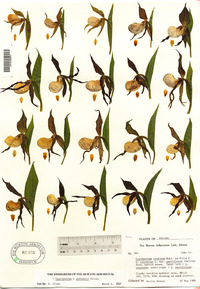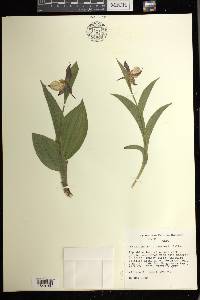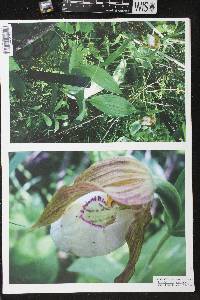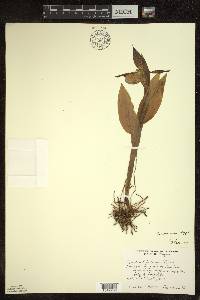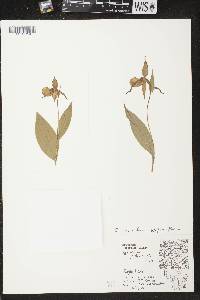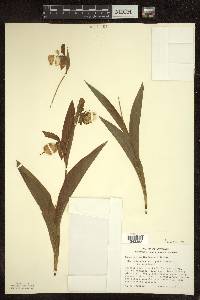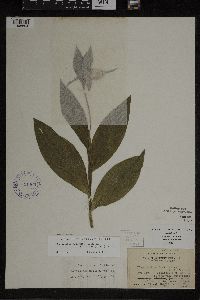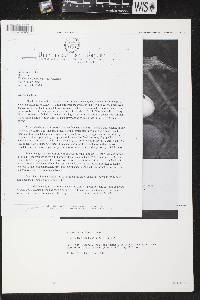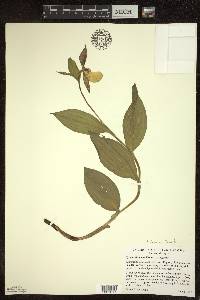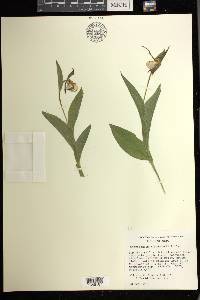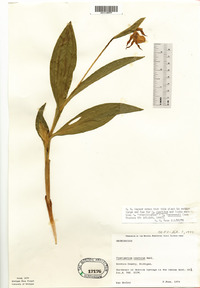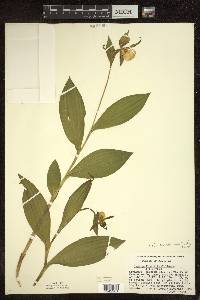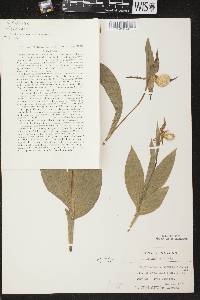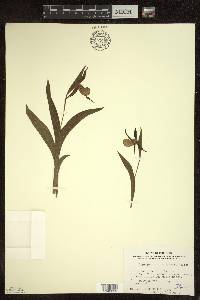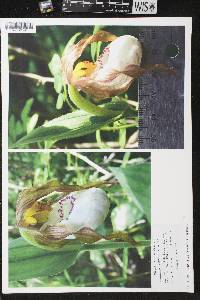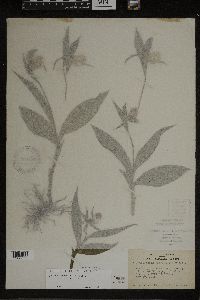
|
|
|
|
Family: Orchidaceae
Andrew's Lady's Slipper
[Cypripedium x andrewsii A.M. Fuller [candidum × parviflorum], moreCypripedium x andrewsii var. andrewsii A.M. Fuller] |
Perennial herb 10 - 60 cm Stem: one, erect, green, leafy, hairy. Leaves: two to five, alternate, ascending, stalkless, green, 5 - 20 cm long, 1 - 10 cm wide, somewhat elliptic, non-toothed, folded lengthwise, strongly ribbed, and hairy. Inflorescence: of one or two, erect, terminal, stalked flowers with each flower closely subtended by a stalkless, erect, green, hairy, leaf-like, 5 - 10 cm long, 1.5 - 4 cm wide, somewhat egg-shaped bract. Flowers: showy, variously colored, often ivory-white or pale cream fading to dull yellow, hairy, bilaterally symmetric with highly modified, very inflated, egg-shaped lip petal. Unlike other orchids, the reproductive parts of stamens and stigma are not fused into a column above the inferior ovary, but instead at the basal opening of the lip petal there are two separate anthers, one large, sterile, modified staminode, and a lobed stigma above the hairy inferior ovary. Sepals: three, but two lower fused together into synsepal positioned behind and below lip petal, with single upper, central, more or less egg-shaped sepal above inflated lip petal. Both the synsepal and upper (dorsal) sepal are hairy, and the same color as the lateral petals, namely either maroon to dark purple-brown (from one variety of parent species) or greenish yellow and streaked with brown (from the other variety of parent species). Root system: of slender, fleshy, fibrous true roots arising from rhizomes. Lateral petals: two, more or less spreading, either maroon to dark purple-brown or greenish yellow and streaked with brown, hairy, 2.3 - 6 cm long, under 1 cm wide, spirally twisted, lance-shaped to more linear. Lip petal: one, central, lowermost, predominantly dull off-white (either ivory-white, or pale cream then fading to dull yellowish), 1.5 - 6 cm long, 1 - 3 cm wide, greatly inflated, pouch-like, more or less egg-shaped, and hairy. On the inner surface of the pouch the veins are usually colored dark purple, which is faintly visible on the outside especially along the bottom, and there is typically purple spotting surrounding and inside the basal opening (orifice) of the petal. Basal orifice with outer edge (opposite staminode) either forming somewhat pointed acute angle, or more blunt obtuse angle. Staminode: one, prominent, yellow with purple spots and sometimes green streaks, more or less broadly triangular, and positioned below upper sepal and pointing down to basal opening (orifice) of lip. On the back side of the staminode the two anthers are positioned on each side of the central lobed stigma. Similar species: Cypripedium x andrewsii is most similar to one of its parent species, C. candidum, but the flowers of that species have a very waxy white lip petal and green to pale brown-yellow (with reddish brown spots or stripes) sepals and lateral petals, the latter which are only loosely twisted or spiraled. The other parent, C. parviflorum has flowers with yellow lip petals, and greenish or yellowish (typically with darker markings) sepals and lateral petals. In this parent the outer edge of the basal opening (orifice) of the lip petal is a blunt obtuse angle, but in the other parent, C. candidum, the outer edge is a pointed acute angle, while the hybrid can have either or intermediate shaped edges. Two different varieties of one parent produce different color variations in the hybrid. The most common combination has genes of C. parviflorum var. makasin, which produces maroon to dark purple brown sepals and lateral petals, but instead of the parent's yellow lip, the hybrid lip is dull white or ivory. When the other variety, C. parviflorum var. pubescens, contributes its genes, the sepals and lateral petals are greenish yellow and streaked with brown, but the lip petal is pale cream then fades to dirty white or dull yellowish rather than being bright yellow. In this latter combination, the sepals and lateral petals are also much longer than those in the other parent, C. candidum. Flowering: May to June Habitat and ecology: Quite rare, in areas where both parent species overlap, mostly saturated, partially shaded dunal swales, especially those with controlled burning. Occurence in the Chicago region: native Notes: This hybrid between C. candidum and C. parviflorum often produces backcrosses as well. This leads to a lot of variation in the flower lip color. Often the lip colors change as flowers mature from first opening to fading to a different tone later. Accordingly, it is not uncommon to have one plant displaying more than one lip color. The genetics of this hybrid can be quite complicated, and two different primary crosses exist depending on which of the varieties of the one parent, C. parviflorum, contributes its genes. Hence the single nothospecies C. x andrewsii, has two different nothovarieties depending on which variety of C. parviflorum crosses with C. candidum. The more common cross, due to sharing more similar parental habitats is C. candidum with C. parviflorum var. makasin, which is named C. x andrewsii nothovariety andrewsii. This produces the more common flower color combination of a dull white or ivory lip and maroon or dark purple-brown sepals and lateral petals. When the rare cross of C. candidum with C. parviflorum var. pubescens occurs, the result is C. x andrewsii nothovariety favillianum (J.T. Curtis) B. Boivin. The flower color combination for this cross yields pale cream lips which fade to dirty white or dull yellow, and sepals and lateral petals that are greenish yellow and streaked with brown. This cross is less common since C. parviflorum var. pubescens occurs in more upland habitats than C. candidum and thus they rarely occur in close proximity. This latter nothovariety may appear nearly identical to the typical variety of the parent, C. parviflorum var. parviflorum, which occurs east and south of the Chicago Region. Etymology: Cypripedium comes from combining the Greek word Kypris for Cypris (Aphrodite), the goddess of love and beauty; and either the Latin word pedis meaning foot, or possibly an orthrographic error for the Greek word pedilon meaning sandal or slipper; together translating roughly to beauty's or lady's foot or slipper, in reference to the inflated lip petal resembling a woman's slipper or shoe. Andrewsii is named after Edward Andrews, the botanist who discovered the hybrid. Author: The Field Museum |


